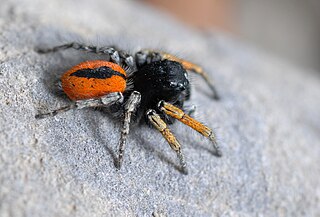
Philaeus chrysops is a species of jumping spider (Salticidae).
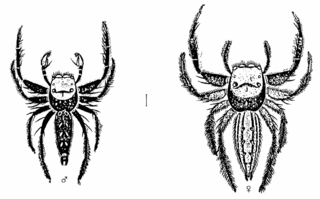
Bavia is a genus of jumping spiders.

Epeus is a genus of the spider family Salticidae. They are often found on broad-leaved plants or shrubs of rain forest, or in gardens of Southeast Asia.
Langerra is a spider genus of the jumping spider family, Salticidae.

Margaromma is a spider genus of the jumping spider family, Salticidae. The eight described species occur mostly in Australia and New Zealand, with several other species on Pacific islands. One species is found in Cameroon.
Servaea murina is the only species of the jumping spider genus Servaea found outside of Australia. It is endemic to Java.
Uroballus peckhami is a spider species of the jumping spider family, Salticidae that is known only from northern Vietnam (Hanoi).
Bristowia heterospinosa is a species of jumping spider from Asia. It was first found on Krakatau, but later also in Vietnam, Malaysia, Singapore, China, Korea and Japan.
Eupoa prima is a species of jumping spider from Vietnam. Described in 1985, it was for some time the only described species in the genus Eupoa; however, since 1997 six new species have been reported.
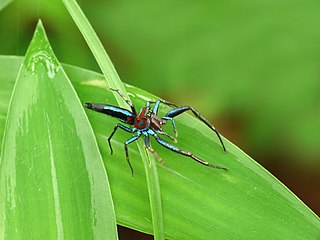
Chrysilla lauta is the type species of the jumping spider genus Chrysilla. It occurs in rain forest from Burma to China and Vietnam. Although known since 1887, it has only been described from male specimens.

Menemerus davidi is a species of jumping spider in the genus Menemerus that lives in North Africa and the Middle East. The species was first identified in 1999 by Jerzy Prószyński and Wanda Wesołowska working initially independently, and then together. The first description was published by Wesołowska, one of over 500 descriptions she produced during her lifetime. The spider is small, with a carapace that ranges between 2.3 and 3.0 millimetres long and an abdomen that is 2.2 and 3.2 millimetres long, although the female is larger than the male. The carapace is generally a uniform dark brown while the abdomen has a pattern of a light brown stripe and white patches that serves to distinguish it from the related Menemerus animatus. Otherwise, it is its copulatory organs that most distinguish the species from others in the genus. It has distinctive internal structure to the female epigyne. The wide copulatory openings lead down the centre of the spider to the spermathecae while there is also a short narrower channel that runs to the rear of the spider with a prominent scent pore at the end. The male has a noticeably smaller embolus and a distinctive dorsal tibial apophysis.

Menemerus minshullae is a species of jumping spider in the genus Menemerus that lives in South Africa, Malawi and Zimbabwe. The species was first described in 1999 by Wanda Wesołowska, one of over 500 descriptions she has completed during her lifetime. She originally identified the male as a different species, named Menemerus manicus, but merged the two in 2007. It is small to medium-sized spider with a cephalothorax that is between 1.9 and 2.2 millimetres long and an abdomen between 2.1 and 3.3 millimetres long. The female is larger than the male and lighter, with a dark brown rather than black carapace and lighter brown abdomen. The abdomen has a large, leaf-shaped, pattern. It lives on Vachellia xanthophloea trees, using its flattened shape to hide under flakes of bark. The copulatory organs distinguish the species from others in the genus. The male has a very short embolus with a larger accompanying conductor. The female epigyne has two pockets that have strongly sclerotized edges.
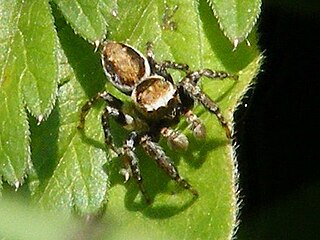
Evarcha awashi is a species of jumping spider in the genus Evarcha that lives in Ethiopia. The species was first described in 2008 by Wanda Wesołowska and Beata Tomasiewicz. The spider is small, with a cephalothorax measuring between 2.0 and 2.3 mm long and an abdomen between 1.9 and 2.4 mm long. The male and female are similar in size but differ slightly externally. The male carapace is orange while the female is brown, both with a darker eye field. The pattern on the abdomen is generally similar, a combination of light background and dark patches, but the female has less contrast between the two. The legs are mainly brown with yellowish tarsi. Its copulatory organs are distinctive. The male has a short embolus that follows the palpal bulb and a sharp tooth on its short wide and blunt protrusion on its palpal tibia, or tibial apophysis. The female has insemination ducts that narrow into multi-chambered spermathecae.

Afraflacilla refulgens is a species of jumping spider in the genus Afraflacilla that lives in Zimbabwe. The spider was first described in 2008 by Wanda Wesołowska and Meg Cumming. Originally allocated to the genus Pseudicius, it was moved to its current name by Jerzy Prószyński in 2016. The spider is small, with a dark carapace that is between 1.7 and 2.2 mm long and an abdomen between 1.9 and 3.0 mm long. It has a very dark, nearly black, eye field, although the male has a very thin white line behind the first row of eyes. The male abdomen is black with a pattern of white spots. The female abdomen is very dark brown, nearly black at the front and yellow to the rear. Both have a distinctive iridescent patch at the back of the abdomen that is recalled in the name of the species, which is a Latin word that can be translated "brilliant". It is this iridescent patch that helps to distinguish the species, although a study of the copulatory organs is needed to confirm its identity. The legs are generally yellow, apart from the front pair on the male, which are brown, longer and stouter and used for stridulation.

Evarcha seyun is a species of jumping spider in the genus Evarcha that is endemic to the Arabian Peninsula. It seems to be common across many of the Emirates of the United Arab Emirates and the Al Mahrah and Hadramaut Governorates of Yemen. The species was first described in 2007 by Wanda Wesołowska and Antonius van Harten. The spider is small, with a cephalothorax that measures between 2.2 and 2.6 mm long and an abdomen that is between 2 and 2.7 mm long. The female is hairier than the male. The female spider is generally brown with a darker eye field, while the male is dark brown with a black eye field. Both have legs that are black, orange and yellow. They can be distinguished from the closely-related Evarcha praeclara by the patterns on their body, including a semi-lunar marking in the middle of its carapace and a light stripe on its abdomen. The species also has distinctive copulatory organs. The female has a characteristic depression in the middle of its epigyne and narrow insemination ducts that lead to complex spermathecae. The male has a spade-like apophysis that accompanies its embolus and a short blunt tibial apophysis.

Hyllus ramadanii is a species of jumping spider in the genus Hyllus that is endemic to Tanzania. It lives in rocky environments. The spider was first described in 2000 by Wanda Wesołowska and Anthony Russell-Smith. The spider is medium-sized, with a brown carapace between 3.1 and 3.2 mm long and an abdomen 3.2 and 5.0 mm long. The female is larger than the male. It can be differentiated from other species in the genus by its coloration and copulatory organs. The male has a pattern of three white patches on its carapace and a horseshoe shape on its abdomen. The female has three irregular orange streaks on its carapace and a yellow pattern that looks like a tree on its abdomen.
Tanzania mkomaziensis is a species of jumping spider in the genus Tanzania that lives in Ethiopia, Ivory Coast, Nigeria, South Africa and Tanzania. First described in 2000 by Wanda Wesołowska and Anthony Russell-Smith, it is a very small spider with a carapace between 0.7 and 1.1 mm long and an abdomen between 0.8 and 1.4 mm long. The male spider's carapace is generally yellowish-orange while the female is brown. All have a darker eye field. The spider's abdomen varies, with some being a plain dark grey, greyish or olive-grey and others, particularly those found in Ethiopia, having a dark mosaic pattern. The spider's legs are often black, but some specimen have paler legs and others have yellow legs with black rings. Its pedipalps are yellow and its spinnerets are grey. The spider has distinctive copulatory organs, particularly the short coiled embolus on the male and the sclerotized fringes on the female epigyne.

Menemerus cummingorum is a species of jumping spider in the genus Menemerus that lives in Zimbabwe. The species was first described in 2007 by Wanda Wesołowska, one of over 500 descriptions she has written during her lifetime. It is medium-sized spider, with a flattened cephalothorax that is between 2.2 and 2.4 mm and an oval abdomen between 2.3 and 2.9 mm long. The female has a larger abdomen than the male. It is also dark brown and marked with a large yellow leaf-shaped pattern compared to the yellowish-grey of the male. Both the male and female have a dark brown carapace, with a pattern of white streaks, a line and five patches, although the pattern is more pronounced on the male. It has yellow legs, the foremost pair being darker and having brown patches. It is similar to the related Menemerus minshullae, but larger.
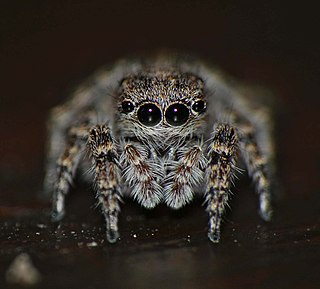
Langelurillus furcatus is a species of jumping spider in the genus Langelurillus that lives in Kenya and Tanzania. It was first described in 2000 by Wanda Wesołowska and Anthony Russell-Smith. The spider is small, with a carapace that is between 1.8 and 2.4 mm long and an abdomen between 1.7 and 2.7 mm long. The male is smaller than the female. It has a dark brown carapace, although the female is lighter, that has no markings. The female abdomen is dark russet with a pattern of black and white patches and the male abdomen is dark fawn with an indistinct light pattern. It has orange legs with dark patches, the female also having dark rings on its legs. The spider is similar to other related species, particularly Langelurillus alboguttatus, but can be distinguished by its two tibial apophysis, which make a V-shape. The epigyne has a deep depression that is plugged with a waxy secretion.

Langelurillus minutus is a species of jumping spider in the genus Langelurillus that lives in Namibia and Zimbabwe. It was first described in 2011 by Wanda Wesołowska and Meg Cumming. The spider is small, with a cephalothorax that is between 1.8 and 2.3 mm long and an abdomen between 1.5 and 3.9 mm long. The male is noticeably smaller than the female, which is reflected in the species name. The species is generally brown, but has indistinct patches on its abdomen and orange or orange-yellow legs. The male has a very convex palpal bulb and the female an epigyne with a large pocket and compact multi-chambered receptacles.














